France and Italy: Best 2 to 3 week itinerary for first-time visitors
France and Italy make for a perfect first visit to Europe, but there are so many potential places to visit that planning well is extremely important. Of the two, Italy is a bit more straightforward because it has a “Big 3” of tourist cities consisting of Rome, Florence, and Venice. France, on the other hand, has Paris, but beyond the capital it can be hard to know where you should go.
These two countries contain several of what I consider to be the best cities in Europe to visit for anyone, so it’s just a matter of narrowing down where to go and how much time to spend in each place. In the article below you’ll see the best option to string together a tour of these countries in two or three weeks. There will be options and decisions you’ll have to make based on your own tastes, but no matter how you do it this should be an unforgettable trip.
This article was most recently updated in August, 2022.
How many cities to visit?
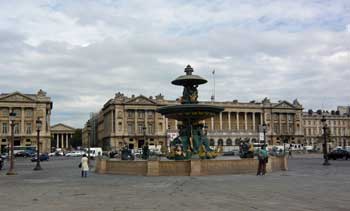
There are many reasons why fast travel might be your best option, but only up to a point. With only a few exceptions, 3 nights per city is a good minimum even for those wishing to see as much as possible, or 2 nights in the smaller cities.
If you are going to France and Italy for sure then start with Paris and Rome as the foundation and add cities in between to the degree you’ll have time. France is a deceptively large country so travel will eat up some time unless you are flying or taking the bullet trains.
>>>Going just to Italy?: Here are the best first-time Italy itineraries for 3 days to two weeks
Flying in and out
Unless you are starting from elsewhere in Europe, you’ll want to carefully choose which airport to fly into. It used to be that Paris was one of the cheapest, and it’s still competitive, but it doesn’t rank high on the list of European cities that are cheapest to fly into.
Two one-way tickets is ideal
It used to be that round-trip tickets were always much cheaper than two one-way tickets, but often that is no longer true. Sometimes the one-way flights are exactly half the round-trip fare, sometimes a bit more than half, and other times they are double. It’s hard to predict so it’s worth comparing them yourself.
The first thing to try is this:
- (your city) to Paris one-way
- Rome to (your city) one-way
Compare that to this:
- (your city) to Paris round-trip
- (your city) to Rome round-trip
If the two one-way flights are within US$150 or so of either round-trip, then they are your best option. If the round-trips are much cheaper then your best option is to buy one of those as well as a one-way flight between the cities (for around US$100) for just before you fly home. It would cost more on the train and also take 14 hours, so flying that last part is the way to go unless you are planning on using the last leg of a Eurail Pass on an overnight run.
Getting around once in Europe
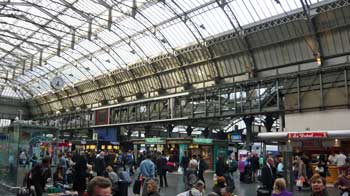
Even on trains, you still have three main options:
- Buying a France-Italy regional Eurail Pass
- Buying individual train tickets in advance
- Buying individual train tickets one at a time when you get there
If you are under 26 you can qualify for the 2nd Class Eurail Pass, which will be ideal for many people. If you are over 25 you have to buy a 1st Class Eurail Pass, and those are probably only best for those with a bit more money to spend.
Best cities in France and Italy for first-time visitors
Paris (minimum 3 nights but even that is rushing it)
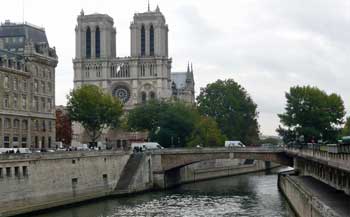
It’s true that you can’t just all of France by just visiting Paris on your first trip, but it’s still not a bad idea because this city is the center of almost everything and even the areas surrounding it are filled with great sights, amazing histories, and plenty of things to do. It’s almost impossible to get a bad meal in the city and most of the food is reasonably priced considering the quality. Be prepared for a small hotel room, even if you pay a lot, so it’s more about paying for the location rather than for a luxurious and large place to sleep.
The sights in Paris are almost all worthwhile, but don’t think you have to spend an entire day in the Louvre in order to enjoy it. In fact, I highly recommend taking the 3-hour double-decker sightseeing tour (run by several companies) on your first day in order to see at least the exteriors of all of the famous landmarks. If you want to go inside at least a few of the big attractions you might consider getting a Paris Pass, which also covers the bus tour and a cruise on the Seine.
Spend at least three nights in Paris itself and if you have extra days you might do a day trip (tour buses are a great choice) of the nearby Loire Valley. It’s filled with famous castles and palaces where the rich used to live outside of the city, and many are available for tours.
Paris to Nice by train: About 6 hours
Provence region (optional 2 or 3 nights)
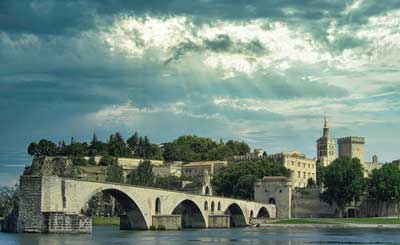
The main city is Arles and that is probably the best base, although Avignon (where the Popes lived) is also very tourist friendly and could be a good choice. In fact, Avignon is the beginning of the famous Côtes du Rhone wine road, which connects a series of hill towns with amazing scenery and of course wine tasting. Something like this might be better for a second or third trip to France unless you’ve got weeks to spend here. Provence is also known for its cuisine, as it stands out even within a country where the food is amazing virtually everywhere you go.
Paris to Avignon by train: About 3.5 hours
Avignon to Nice by train: About 3 hours
Nice, France (minimum 2 nights)
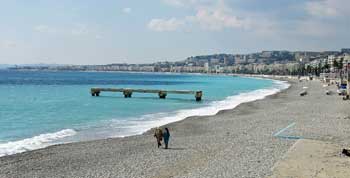
Nice has a famous beach (made of pebbles rather than sand), but it’s also an important cultural capital with great museums and a thriving food scene. You could easily spend 2 or 3 quick days in Nice alone, but you might also consider spending a few hours in Cannes and/or Monaco, which are both only about 30 minutes away by train in either direction. The cheaper hotels in Nice are near the train station anyway, so that’s something to consider if you want to visit all 3 places in one short trip.
Nice to Milan by train: About 5 hours
Nice to Venice by train: About 7.5 hours
Milan (1 night or just skip it)
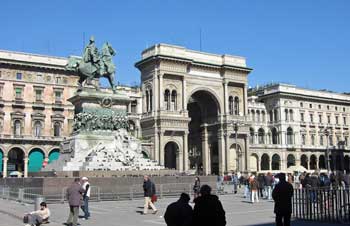
The down side, however, is that Milan is mostly a business/financial city that isn’t as charming as the rest on this list. It’s one of Europe’s fashion capitals as well, but the casual visitor wouldn’t notice. Worst of all, accommodation in Milan can be insanely expensive if there is a trade fair or event in town. If you are coming through in between fairs and events, hotels can actually be unusually cheap, so it’s worth checking rates if you are considering stopping. Generally speaking, I recommend skipping Milan at least on your first trip.
Milan to Venice by train: About 2.5 hours
Venice (1 night minimum, 2 nights maximum)
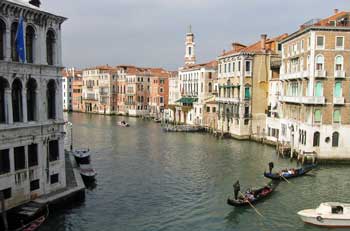
The trick is to stay at least one night, if not two, on the main island itself. Perhaps surprisingly, Venice shuts down early, with most restaurants and bars closed by around 10pm. But in those evening hours as well as the morning hours on the following day, the place can feel magical and like a fairy tale destination. Venice is also quite compact so seeing the main highlights in 24 hours isn’t difficult. Depending on your budget, spend one or two nights on the main island and you’ll be quite satisfied by the time you leave. You’ll be sick of the crowds by then anyway.
Venice to Florence by train: About 2 hours
Florence (2 nights minimum, plus side trips)
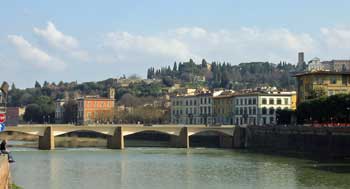
Whether you are coming from Venice or from Rome, this is the point on your trip that you’ll be able to catch your breath a bit. It’s also the cheapest city on this list so lingering here will be more affordable in addition to relaxing. The cuisine here is, of course, world famous, and it can get even better and cheaper if you spend a day or two in one of the many scenic villages in this part of Italy.
From Florence to Rome it’s only around 90 minutes by train, so another easy and pleasant travel day.
Pisa (a few hours on a day trip at most)
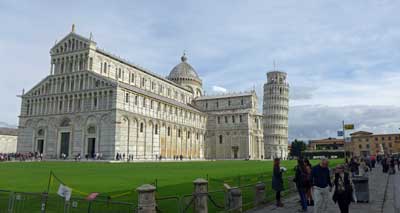
Regardless of your starting point, you can go to the Pisa Centrale train station and walk about 25 minutes to the Leaning Tower area, or take a train to the Pisa San Rossore train station and 7 minutes to the Field of Miracles. There are also bus tours from Florence that take you all the way there, but those come with the slowness of large-group travel.
Cinque Terre (1 night, optional)
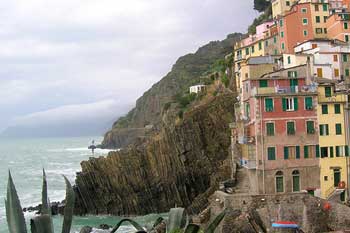
When you see a photo of these villages it’s hard not to be drawn in so if you are in that group you could add a day or two in this area either before or after Florence. Note that the scenic footpaths connecting the towns are partly closed down at times due to instability, so a quick tour by train or even by boat might be a better option.
Florence to Rome by train: About 90 minutes
Rome (minimum 3 nights)
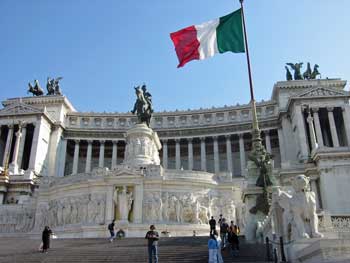
All of that said, Rome is absolutely a must-visit, although you won’t be blamed for hustling through the city quickly and efficiently so you can spend more time in the relative serenity of anywhere else. The Eternal City is also quite expensive, especially by Italian standards, which is another reason to save only a few days there rather than a full week.
Naples/Pompeii/Sorrento/Amalfi Coast (optional up to 4 nights)
The “big 3” in Italy are Rome, Florence, and Venice, and if you have time for only 3 cities those are the obvious ones to choose. But if you want to dig deeper into Italy and you have enough time, your next best choice will be to base yourself in Sorrento and use it to explore Naples, the ruins of Pompeii, the Amalfi Coast, and the island of Capri.
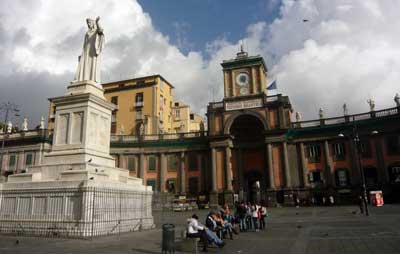
Stay in Sorrento
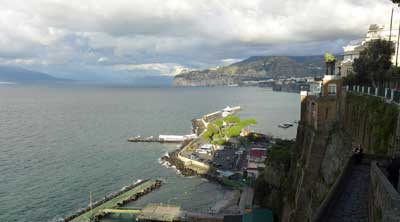
Amalfi Coast and the Island of Capri
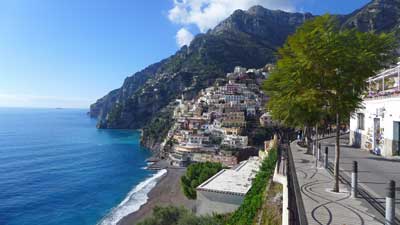
The other main nearby attraction is the famous tourist island of Capri, which is best known for its Blue Grotto attraction. The ferry from Sorrento only takes 20 minutes each way and leaves hourly most of the day. This is another easy and ideal day trip where you can have breakfast and dinner in Sorrento and a wonderful time in Capri in between.
Filling in the rest of your itinerary
If you have only two weeks total then the above minimums will also pretty much be your maximums, give or take a day. But if you have three weeks you will be adding days to these cities or adding new cities altogether. Honestly, if this is your first trip to these countries, you’ll really get the most bang for your buck by adding extra days in Paris or Florence or both.
Rushing around for two weeks can be exhilarating, but rushing around for three weeks can really start to get exhausting. It’s better to plan to go slower and if you are getting bored you can do a day or overnight trip to something nearby. But you won’t get bored, and if you do you are probably doing it wrong.
Cinque Terre photo by World Walk About on Flickr

Hi Roger.
What a nice site you have here. I have a question. My wife and I are planning to go to Europe next year probably around May or September. We plan to spend five days in Paris, four days in Rome, three days in Florence and two days in Venice. While in Paris for five days, we would like to make a side trip to London for one day and another side trip to Bruges for another day? We plan on taking bus tours while in London and Bruges to take in as much sites as possible. Would that be doable and/or practical? What do you suggest?
Warren,
Thank you. Those side trips from Paris ARE possible, although both would be very busy days. The Eurostar leaves from Gare du Nord frequently and takes about 90 minutes each way, but you have to be there at least 30 minutes early (like a flight) and security is pretty heavy so it’s best to arrive at least 45 minutes early. So as long as you book on a morning departure, say, 8 AM, you will arrive at St. Pancras station in London well before 10 AM. It’s fairly center so you could take the tube to Big Ben (which is near loads of other famous landmarks) in 30 minutes or so.
The trains go pretty late, so you could even book a 8PM departure and leave after dinner in London and still be back in your Paris hotel room by 11 AM. It’s important to book at least 3 months out though as fares rise and availability is tougher as the date draws closer.
For Bruges you take the Thalys train, also from Gare du Nord, to Brussels in a bit over 90 minutes and then switch to the local train to Bruges that takes another hour. You need reservations on the Paris to Brussels train, and buying early is also cheaper and better, but at least you can walk on the train just before it departs.
If you are going to do both of those, or even just one, it seems wise to book a hotel close to Gare du Nord. It’s a pretty good and central area anyway, and it will make both of those day trips much easier. Let me know if you have any other questions. -Roger
Hello Roger: My wife and I (both 65) are considering a trip that starts in Nice, and then travels to Italy. Approximately 7 days in duration…coming from the USA. Can you recommennd a good itinerary and estimated ccosts. Whould you recomment a rental car or rail pass? Thanks
Hey Ken,
If you’ve only got 7 days, I’d recommend no more than 3 stops because it takes a good chunk of the day to get from one city to another and check out and into hotels and such. I’d spend 2 or 3 nights in Nice and then head to Italy. The most common stops in Italy are Rome, Florence, and Venice. I’d probably fly from Nice to Venice and spend about 24 hours there and then take a train to Rome for your final 3 nights there. If you had 8 or 9 nights I’d recommend stopping in Florence after Venice for two nights or so.
As for costs, it’s hard to say because everyone has different preferences. If you stayed in modest 3-star hotels (with good locations) and didn’t splurge much on meals, you could do this for as little as about US$100 per person, per day. In other words, you should be able to find acceptable hotels starting around €100 (US$117) per night for a double room, including breakfast. Under the current circumstances I’m sure there are great bargains at nicer hotels. All of that said, you can spend double that amount easily. The flights from Nice to Venice will be cheap if you book well in advance. The trains within Italy are also cheap if booked at least a couple weeks out.
A rental car would be a big hassle, partly because parking is a challenge in every European city. And rail passes are only worthwhile for longer trips where you want to be able to make plans as you go. Let me know if you have any other questions. -Roger
Hello Roger. I found your articles very helpful. My friends and I are planning a first time 3 week trip that may look like this:
Amsterdam-London-Paris-Switzerland (Interlaken and Lucern)-Italy (Rome and Cince Terre)- Prague. We’d have to fly back to Amsterdam for the flight back home. We would be using mostly trains and then a flight in and out of Prague. Do you think this is do-able or what cities should we skip?
Thanks in advance for your help.
Joy,
This trip sounds really great. My general recommendation is to spend 3 nights in almost any European city you visit, but London and Paris are large enough that 4 days is better if you have the time.
The one city I’d recommend saving for a future trip on your list would be Prague. It’s an amazing place, but it’s very far from all of your others so you’d have to fly in and then fly on to your next stop. If you saved that for later you could do all of it by train, except for a flight back to Amsterdam at the end. Taking trains around Europe is FAR more enjoyable than flying around, and you’ll get some great scenery on many of those rides.
For Italy you’d probably have enough time to stop in Venice for a day or so and then Florence for 2 or 3 days on your way to Rome. You might even do Cinque Terre as a day trip from Florence instead of staying there. As for Switzerland, it’s very expensive so you might only spend 2 nights in Lucerne, and perhaps only 2 nights in Interlaken if you are tight on funds. I hope this helps. Let me know if you have any other specific questions. -Roger
Thank you for the detailed information. I am planning a trip and will be adopting this itinerary. Please provide information on the train or even a link to purchase the train tickets from one city to the other based on this itinerary. Thank you in advance for your help.
Temitayo,
For trains originating in France you should book at the official France rail website, and for trains originating in Italy you should book at the official Italy rail website. For nearly all city-to-city trains, the earlier you book the cheaper it can be, so booking a month or two in advance is best. For trains to the suburbs or from between Naples and Sorrento, you can buy train tickets on travel day and it’ll be the same price. Let me know if you have any other questions. -Roger
Hi Roger,
Thanks! Yes you are right! I have to replan the trip I guess..
What do you suggest?
Marseille to Florence, then from there to Venice and then Rome and then back to Marseille? Will this plan work out? Though I still haven’t finalized as to how to travel to Venice from Florence and then from Venice to Rome. I found that there are some high speed trains from Florence to Venice.. do you have any information on that? Also, 2 days in Paris is definitely not enough…but then we can’t do anything about that. Want your help on how to make best use of the two days. My daughter is very very excited about the Paris trip….a typical teenager’s dream is what she is having now – I want her to really enjoy the trip. Eiffel tower is definitely present on the list, Iam a bit confused about the museums though. Any inputs from you will be appreciated.
Thanks for the link on Switzerland. It is really helpful. We will skip the Swiss tour this time and maybe add one extra day to our Italy trip. We aill be in France until Sep next year and so I guess Spain and Switzerland can wait.
Thanks so much!
Nivedita,
Generally speaking it’s much better to use trains than buses in that part of Europe. The trains are almost always MUCH faster (and more comfortable) and if you buy at least a few weeks in advance they tend to be pretty cheap as well, especially in Italy. It’s probably best to get a fast train from Marseille to Milan and then a train to Venice and then to Florence and then to Rome from there.
As for Paris in two days, my best advice is to do the hop-on, hop-off bus tour on your first morning. It takes about 3 hours or so and you’ll see almost all of the most amazing sights and buildings in Paris before lunch on your first day. They leave from just in front of the Eiffel Tower. Nearly everyone wants to visit the Louvre, but it’s so huge that it would take 3 or 4 hours just walking full speed through it, so I’d just look for the Mona Lisa and a few other things that appeal to you and try to spend no more than two hours there. Actually, the Museum d’Orsay across the river is a MUCH nicer museum and filled with classic art, so if you want to more fully explore one museum I’d choose that one. I have a lot more advice on my review of the Paris Pass. Even if you don’t buy a Paris Pass I think it’ll be helpful. Let me know if you have any other questions. -Roger
Hi Roger,
Your site is simply awesome! The patience you have in replying and clarifying doubts is just amazing. I too need your advice in planning my itinerary. Iam right now in Manosque, France – came here just a month back from India as my husband has been posted here. In January my niece is visiting us and she wants a trip to Europe. We (myself, my husband and my 16 year old daughter) have not ventured out anywhere so far…not even to Paris. My niece will be arriving in Paris on Jan 14 2020. So right now what we have planned is we will go to Paris on 13 Jan night from Aix (TGV) and planning for PAris trip for 2 days. We need to be back in Manosque on 16th. We are planning to visit Nice, Antibes, Cannes, Monaco on 18th and 19th. Then planning for a trip to Italy and Switzerland (my daughter and niece are adamant about Switzerland though the weather there is going to be extremely cold). WE have just 6 days ie 20 Jan to 26 Jan. 26 Jan night or 27 morning we need to be back in Manosque. Is it doable? How do you suggest we plan it?
Marsielle to Florence (bus)
Florence to Venice, then to Rome (20th, 21st and 22 nd )
Rome to Spain is possible? (maybe Barcelona?) (23 and 24?)
How do I travel to Switzerland? It is confusing…my husband says we are closer to Switzerland and so we should plan th from here itself. WHat do you suggest? I think my query is as confusing as Iam right now. Can you please help?
Thank you so much!!
Nivedita,
I’m happy you are finding the site to be helpful. My standard recommendation is to spend 3 nights in almost any European city that you visit. That said, I think you could enjoy Italy in 6 total days with one day in Venice, two days in Florence, and three days in Rome. Those cities are about two hours apart by train and by the time you check out of one hotel and check into a hotel in the next city, half the day will be gone. You could save Florence for a future trip, but I wouldn’t recommend trying to see each city in just one day.
From where you are you’d have to get to Geneva to enter Switzerland and I’m not sure how long that takes to get there. From Geneva you are still several hours from the better tourist areas by train. This article about where to go in Switzerland should help you plan that trip at least.
I definitely wouldn’t try to add Spain onto an Italy or Switzerland trip unless you had at least 3 days to spend there. Most of these cities are pretty large and packed with wonderful sights. If you only have 4 hours for sightseeing you’ll be able to see one or two things at most and then you’ll have to have dinner and prepare to leave the next morning. I’m happy to help you plan this trip, although I think you need more time or fewer places to try to fit in. -Roger
Hi Roger,
Your detailed itinerary has been very helpful! I am in the process of planning my honeymoon and wanted to run through some ideas. We are planning to travel August 2020. So far, this is what I have come up with:
Fly to Paris (3 nights) (maybe Versailles as well?)
Nice (2-3 nights) with trips to Cannes, Monaco
Cinque Terre (1-2 nights)
Florence (2 nights)
Milan on way to Lake Como (2 nights)
Fly back home from Milan
3 years ago, I did a trip to Italy and saw almost all the cities on my wish list (Rome, Florence, Pisa, Tuscany (San Gimignano, Chianti, Sienna), Capri, Postiano, Amalfi, and Venice. My finance has been to Rome and Venice before as well. We are trying to not repeat cities we have already visited but I thought Florence would be a good city to repeat together.
Any tips on must do places between the French and Italian Rivera? Also, what would be the best way to travel from Nice to Cinque Terre? Both of us have an infinity to Italy but want to make sure we spend our ~2 weeks seeing the most of these places.
Thank you in advance!!
Tehreem,
I’m glad the above article has helped, and I think your plan sounds very good. It’s great that you’ve seen so much of Italy already and I agree that seeing new places is usually better. Paris in August is wonderful because the city feels half empty since so many office workers are gone for the month.
I think your plan for the France and Italy coasts is good, although parts might be tricky. The reason that Paris feels half empty in August is that so many people are on the coasts, so the Riviera will be packed and at the highest hotel rates of the year. If you book something early you should be able to get good value, and the hotels only hold so many people so it’s not like there will be sleeping in the streets, but it will be crowded. With only 2 or 3 nights I agree that spending time in Nice itself is wise (it’s a major highlight and the best transportation hub), and half a day in Cannes and half a day in Monaco are the two best day trips (each 20 minutes away by train).
Now, as for the Cinque Terre, those are five tiny villages (unlike those larger French cities) and people say they have become so crowded that it’s hard to enjoy them anymore. August will obviously be a peak time to visit, so it’s hard to say whether you should join the crowds. There are other less-famous Italian beach towns closer to Genoa that you might try instead, and then you can at least take a train for part of a day to see Vernazza, which is arguably the most photogenic village. Either way, you can take a train from Nice to Genoa in 3 to 4 hours and then transfer to the local train that goes to La Spezia, and also stops in all five villages. From La Spezia to Florence you can take a fast train.
Lake Como will also be at peak crowding in August, but it’s a pretty large area and if you book early you should find something nice at a decent price. As always, let me know if you have any other questions. -Roger
Hi Roger,
Thanks to your page I find this really helpful!
We’re traveling to Europe during the holy week to first week of May. Do you think this is a feasible itinerary considering we want to attend easter sunday mass at the Vatican and visit Disneyland in Paris?
Rome – 3 days
Florence – 2.5 days
Venice – 1.5 days
Verona – 1 day
Amsterdam – 2.5 days
Paris including Versailles – 4 days
If you can also provide some tips as to which places we should consider getting passes and taking hop-on/hop-off buses.
Thanks!
Claire,
I’m glad you find this useful. I’ve not been in Rome during Holy Week and I hear it’s quite crowded, but as long as you have hotels and trains and flights booked well in advance it should be great.
Your itinerary should work well. You can take trains within Italy and then fly from Venice or Milan to Amsterdam, and then the high-speed train from Amsterdam to Paris to finish the trip out.
The Rome and Vatican Pass is a good deal as long as you are doing the included attractions, but that week some of them might be very crowded.
The Paris Pass is also a good deal for most people and it includes my favorite hop-on, hop-off bus tour in the world (I’ve done dozens of them and Paris is the best). I also highly recommend the included Seine River cruise shortly after sunset. The Amsterdam Pass can be a good deal if you want to see a lot and aren’t fond of walking, but for most people it’s not ideal. Let me know if you have any other questions. -Roger
Thanks for the comments Roger. Definitely taking them on-board. I’ll check out the accommodation options then make a decision. Sounds like we don’t miss anything by not seeing Murano and often it makes planning easier, knowing what NOT to see, as much as knowing what TO see… Chris.
Hey there Roger. We have 2 nights at Venice but not sure yet if we will stay on the main island or on the mainland. Since budget is a big concern for us I assume it will be the mainland. If that is the case, and we spend just 1 full day on Venice itself do you think it’s worthwhile seeing the other islands (e.g. Murano & Lido) or would you stick to the main island? Thanks
Chris,
I’ve spent most of my time on the main island and I highly recommend staying there if you can possibly afford it. As I’ve said so often, the main island is where all of the big sights are located and it’s packed to the gills with cruise passengers and day trippers from about 09:00 until 18:00 each day. So the best strategy, if you can pull it off, is to pay a bit more to stay on the main island and then wake up early to wander around before things get crowded, and then wander around in the evening when most of the crowds have left. Restaurants there close pretty early (most by or before 10pm) so it’s not a party island, but it really is lovely with fewer people around.
I haven’t been to Murano or Lido, but I’ve heard quite a bit about them. Murano, as you probably know, is where many people go to check out a super-touristy glass factory and sometimes buy overpriced souvenirs. Lido, on the other hand, is quite nice and much less crowded so that could be a good place to escape from the crowds in the middle of the day. You can get back to the mainland any time in the evening so you can still stay later and have dinner there. It’s just that most visitors are so worn out from the crowds by the end of the afternoon that they prefer to head back to their hotels (or buses) and have dinner somewhere else. -Roger